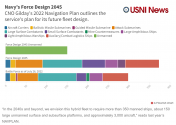I agree. Our public opinion of military and military spending has already shot down in recent years, now we are debating the newest 890 billion dollar defense budget, adding another 50 billion or so would get us to nearly a trillion. The public in this country loves a strong defense, but not at the cost of every other damn program we need to also function in this country, or at least I hope they don't.Who's going to buy these over-priced ships, built by inexperienced workers? And if they are subsidized to be competitive on the market, I don't think we can afford to spend dozens of billions on subsidizing an industry just in case we need wartime production.
You are using an out of date browser. It may not display this or other websites correctly.
You should upgrade or use an alternative browser.
You should upgrade or use an alternative browser.
US Military News, Reports, Data, etc.
- Thread starter tphuang
- Start date
I agree. Our public opinion of military and military spending has already shot down in recent years, now we are debating the newest 890 billion dollar defense budget, adding another 50 billion or so would get us to nearly a trillion. The public in this country loves a strong defense, but not at the cost of every other damn program we need to also function in this country, or at least I hope they don't.
Yep.
If the government was honest, they would say it how it is. We severely underestimated China, and the only way we can catch up is we travel back in time 20 years ago to make the investments we needed to.
We severely underestimated China, and the only way we can catch up is we travel back in time 20 years ago to make the investments we needed to.
The two main limiting factors are personnel cost and the limitations on funding imposed by other branches which also increased in number recently - Space Force will be the biggest funding problem in coming years as it is a nascent force in a nascent domain.
Without radical restructuring of the budget to benefit the navy or an overall increase in funding (the other branches will require equal share) the US naval power is already above its natural sustainable ceiling. Most people forget what level of funding was provided in the past and where it went
year and budget in constant 2021USD billion (SIPRI), and total personnel, active conscription in grey:

If you consider conscription and wars (Korea 51-53, Vietnam 61-75 with major escalation from 63, GWoT) it becomes clearer why the US was able to fund naval expasions like in the 50s/60s and why crisis in the 70s forced fleet reduction and hi-lo mix, how Reagan era increase fits into it and the rest. Also note that the growing budget likely reflects also the personnel cost because retirement obligations accrue over time. Add higher cost of more complex equipment and overall higher cost of procurement and it explains why today's $800bn buys less than 1960s $500bn in constant 2021 dollars.
This is Battle Force Inventory 1945 to 2020:

With that being said:
----------------
War in Ukraine diverted my attention for the last year so I missed the publication of the next 30-year shipbuilding plan in April. It's interesting because it has updated numbers compared to the plan from December of 2020 and these two can be treated as "outgoing Trump admin" and "outgoing Biden admin" proposals.
In tables below I indicated general election years to better illustrate key periods for decisionmaking. Considering that the current budget is flatlining at around ~$900bn I think PB2024 or "2024 low" is a realistic estimate. There is a third mid-level proposal "PB2024 Alternative 2" but I ignored it because it doesn't introduce any meaningful change compared to lower and upper bounds. Also the main difference between the plans lies in support vessels, not the combatants.
deliveries - by shipbuilding plans: 2020 vs 2024 low vs 2024 high

SSN production flatlines at average 2 per year. SSC never crosses 2 per year. LSC drops to 2 per year past 2036. That indicates no room for expansion and production atrophy but that was long time in the making. The last 20 years or so was pretending that outsized fleet was economically viable similar to what Russia has been doing at the time.
Battle Force Inventory - by shipbuilding plans: 2020 vs 2024 low vs 2024 high

If we compare 2028 and 2036 as key milestones then 2020 plan overshot significantly. The expansion of SSN production failed at current funding and investment levels and is likely to struggle in the future considering how Columbia, Virginia and refits are going. By 2048 USN seems to be left with just 60 SSNs maximum. On the surface it's only 85 LSC in 2024 vs 92 LSC in 2020 and more importantly only 24 SSC vs 36 SSC. That keeps the total surface combatant fleet at 109 vessels instead of 128 with ongoing emphasis on expensive DDGs which will drain funding for manpower. Note how amphibious ships are kept below the previous expanded level with LAW (Light Amphibious Warship) and the number falls further past 2036 to 21 ships in 2048. Considering that the ESG (Expeditionary Strike Group) requires currently three ships (1x LHD + 2x LPD) to carry a battalion-sized expeditionary unit it indicates that there are fewer ESGs planned. The new USMC doctrine Force Design 2030 doesn't allow reduction in footprint for expeditionary forces sufficient for only two vessels (1x LHD + 1x LPD). This likely indicates reduced involvement in some areas of the world but I won't speculate where those may be.
In comparison PLAN around 2028 is going to reach approximately ~55 LSC and ~100 SSC (of which ~45 FFGs). Capital ships (carriers and large amphibious ships) and logistical support need to catch up - but those match doctrine and strategy (and not USDoD tables or ChinaStronk trolls) so these numbers may be very different. That leaves submarines to match the projected 50-60 SSNs over that period.
This puts significant pressure on US allies to fill the gap in terms of numbers and capability and that's not happening for Australia, Japan is largely stagnated in terms of navy size and Korea is modernizing but not expanding significantly. Which only leaves India - which also struggles to expand its navy - but India operates on a different ocean.
The strategic layout is just being set through production capacity and that fundamentally determines what conflicts will and will not be fought, save for a random black swan event.
Why I suggest PLAN marines should change:
It has to do with them becoming a proper marine force than responding to what USMC does. Any form of assertive foreign policy in the region will sooner or later require force projection whether there is a war or not. I don't like the concept of parallel armies because that's something that emerged from legal constraints in the US and this is why I would make both PLAN marines and select PLAGF units more "marine" and integrated under joint ops. Give marines the edge but never expect them to be a land force. For that an airborne unit of PLAGF trained in jungle and mountain warfare is better. There's no reason why "marines" have to be a separate branch.
France has navy marine units (Fusiliers Marins) which number 1800 and army marine/expeditionary units (Troupes de marine) which number 17 000. Fusiliers Marins establish beachheads and are first line and then Troupes de marine follow. American system is unique to America for historical reasons and should not be replicated.
I also think that the density of marine traffic in WestPac littorals makes it viable for PLAN marines to train as boarding units. Quite literally fighting ship-to-ship and considering the "marine militia" can provide that type of battlefield I think it is a very relevant direction.
Aren't there already 3 PLAGF Group Armies (each with 2 Amphibious Assault Brigades) primarily tasked with establishing beachheads? That allows the rest of the Group Army Brigades can disembark.
I see the PLAN marines primarily being tasked with distant expeditionary operations beyond Taiwan or specialist marine operations.
Why such move would be better for countering FD30 USMC:
Force Design makes marine units very adept at dodging attacks. They can slip by a massed attack and evade a direct strike. What they can't do is fight while someone is constantly disrupting their maneuver. It's more go than chess. You don't go after them directly as much as post your forces in places that will restrict what they can do - specifically making it more difficult to evade detection. It's also about distribution of decision-making and scale. If a Marine missile unit launches a missile it's better if a PLAN marine unit on a nearby island counters them rather than wait for PLAAF sending a GJ-11. If a GJ-11 is indeed sent it's better to have information fed from nearby positions. Better yet if nearby unit constraints USMC maneuver so that GJ-11 can strike it.
I don't think that such a force needs to engage US Marines directly. They will have an advantage against detection but if detected they will be more vulnerable compared to their previous structure. So perhaps just PLAN MF presence will provide sufficient deterrence against aggressive operations?
In the end I don't have all the data to engage in meaningful speculation. I can only attempt to correct the course of thinking when I see people going in a direction that I know is wrong. Ultimately only PLA knows what it wants to do and we don't. Ignoring FD30 altogether is also a viable solution if in the end it doesn't disrupt PLA strategy and operations.
I don't see FD30 marine units (deployed on small islands in the First Island Chain) being able to effectively hide. There literally isn't enough space or cover.
Plus resupply will be a huge issue as well, perhaps impossible?
First of all you forget the rule of war: don't do anyting that Russia does. That's obviously a joke except not really.
Russia's choice to employ Iranian drones en masse was largely a desperation measure aimed at achieving psychological effect and it was nowhere near as effective as Russian propaganda claims. Such drones can be used to saturate air defenses if used in numbers much greater than what Russia did in Ukraine but they will not have any other effect.
Yes, if we look at Russian usage of Shaheed-136 piston-engine drones, they send like 20? at a time.
But if we talk about much larger numbers (given that China could likely build these at $20K each), this will saturate enemy air defences, which is very useful considering defensive SAMs are many times much more expensive. If an expensive SAM is used to shoot down a low-cost Shaheed-136, the Shaheed-136 has succeeded in its mission.
Piston engine is too inefficient to carry a sufficiently large warhead at a sufficiently long distance. They are not difficult to shoot down. Ukraine shoots down the overwhelming majority of them.
It depends on how large a warhead is needed.
Remember there are a bare minimum of 5000 soft, fixed infrastructure targets all over Taiwan for example, where a Shaheed-136 warhead should be sufficient.
And it's not like a Shaheed-136 wave would go in by itself.
You would time it with other larger missiles and/or an airstrike with SEAD aircraft going after the air defences which have to reveal themselves.
As for Shaheed-136 range, it is likely 1200km+, which covers all of the First Island Chain (Japan, Korea, Taiwan) from Mainland China.
After that, there is literally nothing until Guam some 3000km away.
The Battle Force Ship Assessment and Requirement, a congressionally-mandated report, requires 381 ships, up from 373 in the 2022 report, the first year it was released. As of Monday, the Navy’s battle force was 299 ships.
For reference, here's the original 373-ship requirement outlined by the Force Design 2045 published by the US Navy in 2022.

To be honest, I'm actually expecting unmanned naval units (both surface and underwater) to occupy an even greater portion of the entire fleet (in terms of numbers) than just 30% by then.
What do you guys think?
Last edited:
The 30% figure refers to "Large unmanned surface and subsurface platforms". If you include all smaller unmanned vehicles, the number will rise substantially. I think the 30% figure for larger unmanned vessels in 2040s is realistic.What do you guys think?
Seems like the Space Force is expecting to ramp up the launch of all satellites over the next five year period (Phase 3), in particular large sattelities costing $1 billion+ are expected to have 59 launches during this timeframe. The National Security Space Launch (NSSL) Phase 3 will last from 2025 through 2029. The total number of launches including smaller satellites payloads will be around 90 during this time frame.
As part of this increased launch cadence, the Space Force has opened the NSSL program to more contenders which likely means Blue Origin will be able to score some launches during this time frame (assuming they are able to get their launcher ready).
This also would likely mean increased investments in launch infrastructure to support the cadence of not only these military launches but also greater commercial launches as well.
Maybe missile row will be fully activated like it was during the 60's!

As part of this increased launch cadence, the Space Force has opened the NSSL program to more contenders which likely means Blue Origin will be able to score some launches during this time frame (assuming they are able to get their launcher ready).
This also would likely mean increased investments in launch infrastructure to support the cadence of not only these military launches but also greater commercial launches as well.
Maybe missile row will be fully activated like it was during the 60's!

Looks like something out of Gundam lolSeems like the Space Force is expecting to ramp up the launch of all satellites over the next five year period (Phase 3), in particular large sattelities costing $1 billion+ are expected to have 59 launches during this timeframe. The National Security Space Launch (NSSL) Phase 3 will last from 2025 through 2029. The total number of launches including smaller satellites payloads will be around 90 during this time frame.
As part of this increased launch cadence, the Space Force has opened the NSSL program to more contenders which likely means Blue Origin will be able to score some launches during this time frame (assuming they are able to get their launcher ready).
This also would likely mean increased investments in launch infrastructure to support the cadence of not only these military launches but also greater commercial launches as well.
Maybe missile row will be fully activated like it was during the 60's!

